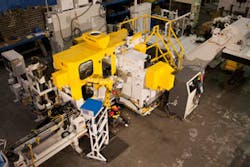C & B Machinery Develops Double-Disc Grinding System for GM
Overview of C & B Machinery’s reciprocator double disc-grinding cell.
A robot places finished connecting rods in an outgoing sliding beam conveyor.
C & B Machinery has been contracted by General Motors to supply two special, double disc-grinding systems to finish-grind both coplanar and non-coplanar connecting rods for the auxiliary 1.4-liter engine in its new electric-powered Chevy Volt.
The Volt is a plug-in hybrid electric vehicle that GM will introduce later this year, to be powered by electrical energy supplied by on-board lithium-ion batteries that are charged by connection to an electrical outlet. The car's 16-kWh lithium-ion battery pack can be fully charged by plugging the car into a residential electrical outlet. The gasoline engine is installed as a backup power system.
C & B Machinery designs and builds grinding machines for automotive and other high-volume applications. Along with its line of double disc grinding systems, it rebuilds and services other major brands of grinding machines.
Double disc grinder machines grind both sides of flat parts at the same time, using opposing wheels. The C & B Double Disc Grinder is equipped with horizontal spindles. All four faces of the Volt’s connecting rods are ground simultaneously to extremely tight tolerances. The Turbo version of this connecting rod has unparallel (or non-coplanar) surfaces, with the crank end 1.2 mm narrower than the pin end.
The challenge of the design was to produce this non-coplanar connecting rod from a parallel or coplanar rod. C & B Machinery developed this grinding system to remove 1.8 mm of metal stock from the crank end and 0.6mm from the pin end — in one cycle. All four faces are ground simultaneously, and the production rate is roughly 200 parts per hour.
According to C & B’s information, this grinding process is unique. Similar, conventional methods have been attempted by other manufacturers in the past, but never have proved successful.
The first grinder shipped to GM earlier this year produced flatness and parallelism of the rod faces within 4 microns on average, repeating within 1-micron. Size range is held within 25% of print tolerances and repeats within 3 microns. The step relationship from crank face to pin face is held within a range of 6-microns, C & B states.
This state-of-the-art grinding system is equipped with a robot that:
- Unloads finish ground parts;
- Positions every part in front of a camera, which ensures the part, is oriented correctly; and
- Places the part into an automatic gauging system that fully inspects the pin-end thickness, the crank-end thickness, and the step relationship.
The machine also makes a positive impact on the environment: it has no hydraulics, its motors require less energy than more conventional machines, and the coolant filtration system uses no disposable filter media.
